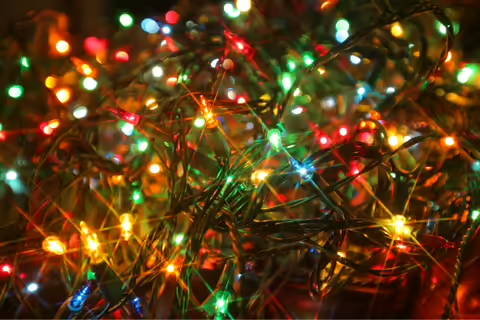SPRINGFIELD, Ill. – While most daily activities have been turned on their heads in 2020, holiday decorating can bring some much-needed normalcy this year. While many started decorating long before the turkey and pumpkin pie, still millions of others use Thanksgiving weekend to hang their twinkling lights and place other treasured trimmings that signal the beginning of the holiday season.
Before rushing through decorating to enjoy a well-lit house or yard, take time to plan out the job safely. “Unfortunately, every year people are hurt in decorating accidents, including mishaps or serious accidents that involve electricity,” says Erin Hollinshead, executive director of Safe Electricity. “We tend to get eager to finish decorating so we can enjoy the lights, but it’s best to take your time, think before you start, and don’t forget to put safety first."
The U.S. Consumer and Product Safety Commission reports that 14,700 to 18,100 people were treated in emergency rooms in recent years due to holiday-decorating injures. Those injuries include those caused by falls, cuts, and back strains, as well as injuries from electrical hazards.
Be on the lookout for damaged lights, plugs, and electrical cords, and especially be aware of overhead power line locations when carrying or using ladders or when stringing lights, Hollinshead says.
Safe Electricity provides these additional holiday decorating safety tips:
Decorating and lighting
- When using holiday lights, whether indoors or out, look for certification by an accredited independent testing laboratory, such as UL.
- Make sure the lights are properly rated and only use lights rated for outdoor when placing outside.
- Before hanging your lights, check the strands for broken bulbs as well as fraying or bare wires that could present electrical hazards. Always discard damaged strands.
- Turn off all lights before leaving home or going to sleep or ensure they are timed to do so.
- When securing light strands, never staple or nail them into place; instead use plastic hooks.
- Many of today’s light strands are made of LED lights, which produce light without the heat of conventional incandescent bulbs. They are popular for good reason, since the lifespan of LEDs is 25 times that of incandescent lights. They also are much more energy efficient than traditional bulbs.
- When decorating outside, always be sure to look up and out for overhead power line locations. Make sure that you and any equipment you are using, such as a ladder or a light strand, stay a minimum 10 feet away from overhead power lines.
- Follow the manufacturer’s instructions for the number of light strands you can strand together.
Extension cords and outlets
- Check that the extension cord you use is rated for its intended use, especially if used outdoors.
- Never run extension cords under carpets, through doorways, or where they could be damaged by furniture.
- Lights and decorations that are used outdoors should be plugged into an outlet with ground fault circuit interrupter (GFCI) protection. GFCIs detect and prevent dangerous situations where an electric shock could occur.
- Puppies and other pets love to chew on electrical cords, including light strands and extension cords. Keep cords out of sight or hidden with a cord cover. Provide teething or play alternatives.
- Be careful when using extension cords around crawling babies and toddlers. Check for long electrical cords that span the floor and secure them with cord covers to avoid trip/crawl hazards.
Tree selection and placement
- When selecting your tree, make sure that you consider the safest option for your home.
- If you are decorating with an artificial tree, make sure you choose one with fire resistance protection.
- With a real tree, make sure that the needles are green and sturdy with a trunk that is sticky with resin. These are indicators that your tree is well-hydrated.
- Keep your real tree stand filled with water so that the tree does not become overly dry and present a fire hazard.
- Always consider the optimal placement of your tree. Ensure that your tree is placed at least 3 feet away from heat sources such as fireplaces or radiators and on a stable platform.
Safe Electricity hopes your season will be safe, merry and bright. For more information on electrical safety, visit SafeElectricity.org.
Source: Erin Hollinshead, Executive Director, Safe Electricity
Writer: Ann Augspurger, Communications Director, Safe Electricity
Safe Electricity is the award-winning, public awareness program of the Energy Education Council, a 501(c) 3 (not-for-profit organization) established in 1952 on the campus of the University of Illinois at Urbana-Champaign. With offices located in Springfield, Ill., Safe Electricity operates under the University of Illinois Extension and is led by the EEC Board of Directors. Since the Safe Electricity program was created in 2001, it has provided thousands safety-minded resources to its more than 500 utility members from across the country to help save lives and reduce injuries.
ABOUT EXTENSION: Illinois Extension leads public outreach for University of Illinois by translating research into action plans that allow Illinois families, businesses, and community leaders to solve problems, make informed decisions, and adapt to changes and opportunities.
